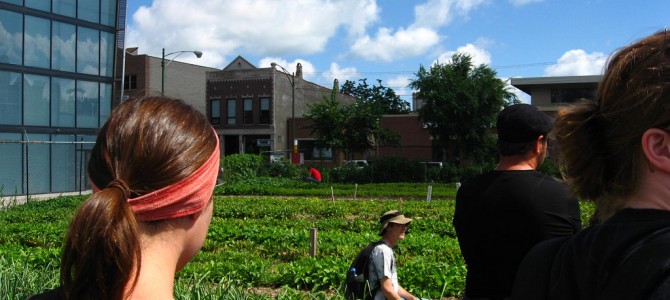
We are used to a “country versus city” dichotomy. It’s not just typical to American society—the polarity has created a lot of class, cultural, and political differences throughout the world. There are a variety of disparate mores usually cultivated in the two separate communities: one is usually more liberal, the other more conservative, one more focused on the individual and careerism, the other more focused on the family. Urban folk and agrarians are often at odds with each other, representing different camps in larger political and ideological debates.
But what happens when people bring the country to the city?
Urban entrepreneurs are introducing vertical, rooftop, and indoor farming, as well as “urban homesteading,” to American cities. Each of these ideas, in its own unique way, builds agriculture within a city and turns barren concrete landscapes into something productive and beautiful. But on a more abstract, philosophical level, urban farming could have conservative implications and outworkings—and we should encourage these endeavors as much as possible, in our efforts to bring traditional principles back to urban environments.
Urban Farming Opportunities
First, urban farming presents an interesting opportunity for innovation and creativity amongst American entrepreneurs. Some aspiring urban farmers have built vertical farms and are using methods like hydroponics or aeroponics to cultivate produce with marked efficiency. Rooftop farms are also becoming very successful, and can yield as much as 20 times the produce of a traditional farm. Gotham Greens, a rooftop farm in Brooklyn, uses a computer control system—with sensors, lights, fans, shade curtains, heat blankets, and irrigation pumps—to grow vegetables year-round. Some may find these things strange and foreign, unseemly compared to more traditional forms of farming. But as long as they’re meant to supplement and not replace traditional modes of agrarianism, such efforts present opportunities for people to learn more about food production, and to harness new knowledge in an effort that benefits communities and fosters ingenuity.
Urban farming can also have a philanthropic bent: one community farm in Baltimore specifically tries to fight the city’s rampant “food desert” problem. Food deserts are urban areas where supermarkets are more than one-quarter mile away, the median household income is at or below 185 percent of the Federal Poverty Level, 40 percent of households don’t own a vehicle, and the Healthy Food Availability Index score for surrounding stores is low. Large pockets of Baltimore qualify as food deserts under this definition. Jaunita Ewell’s Cherry Hill farm sprung up from a 1.5-acre, garbage-filled field. She now grows food for the community, selling it at a neighborhood stand and local farmers market. Conservatives often talk about fighting poverty via innovation and entrepreneurship: urban farming could be one method for providing alternative food methods for the needy, while also supplementing jobs in needy urban areas.
But urban farming extends beyond communal plots and vertical wonders. It’s also been widely adopted by an entrepreneurial group of “urban homesteaders” who are starting their own mini farms in various American cities. Not only do these people own chickens or tend gardens, some use sheep or goats to mow lawns, create their own compost, and can, dry, or ferment their own produce. Such methods (while they may seem eccentric and hipsterish to some) present a much more affordable way to eat and tend one’s property. Even a modest vegetable garden can replace a sizeable portion of a family’s grocery bill, and if produce is well-preserved, can become a yearlong resource. If chickens are well cared for, they can produce a remarkable amount of eggs—both beneficial for personal use and easy to sell.
Aside from more practical and philanthropic concerns, we can appreciate the aesthetic benefits these efforts bring to many urban communities. Modern urban landscapes are often ugly squares of concrete, occasionally punctuated by potted plants and parks. But Ewell’s Baltimore initiative turned a field of garbage into a pleasant and useful space. The benefits she reaps for her community aren’t merely humanitarian—they’re aesthetic, as well. Rooftop and vertical farming initiatives can give an otherwise monochrome city the benefit of greenery and life.
Not All Sweetness and Light
That said, several important issues will have to be addressed if this trend continues: last year, several aspiring urban farmers were abandoning roosters at local animal shelters. Many people immediately rebuked these irresponsible urbanites for their wimpiness and negligence. But when National Public Radio looked into the situation, it was able to reveal some of the deeper nuances involved. These weren’t all cases of abandonment or maltreatment. It had more to do with the fact that many cities have banned roosters as backyard coops become more popular. Roosters are usually rowdier than hens, and more likely to cause neighborhood disturbances. But homesteaders who buy chicks online can’t determine the chicks’ sex until they grow older. Thus, as NPR put it, “Once the poor fellows start crowing, their fate is sealed: It’s either the frying pan or the local humane society.”
This story reveals two interesting issues that will have to be worked out in the urban farming world: first, aspiring homesteaders will have to learn how best to care for their plants and animals, and will have to exercise responsibility in caring for their new charges in a largely farm-hostile environment. Urban farmers cannot embark on their ventures without properly researching their work and knowing what they’re getting themselves into. Chickens, for instance, are a lot of work, and can attract rats, foxes, raccoons, and other pests. They take care and attention to keep healthy, and need a proper environment for laying eggs.
At the same time, cities will have to figure out how to work with urban farmers—to encourage innovation, while also placating neighbors and tending their streets. Many cities may want to encourage this trend, but also worry these farmers are just young and well-intentioned hipsters who will make a mess the city has to clean up. Cities currently are limiting the amount (and often sex ratio) of animals that urban farmers can have, but these regulations often cause more frustrations for successful homesteaders than they actually prevent animal disturbances or maltreatment. One of the most important issues that needs to be debated and considered are city zoning laws that dictate when and how urban farmers can sell their produce to neighbors. This is, after all, the reason many of these farmers work in the first place: besides building a self-sustainable lifestyle, they also want to create an entrepreneurial system whereby they can provide food to neighbors. Mixed zoning and opportunities for farmers’ markets will help build a more vibrant, social community landscape.
On a more philosophical level, it’s worth considering what these practices may bring to the city: what ideas and mores they may foster, and whether they may even bring some rural values to the heart of urban society. When people are more connected to their food source and more responsible for their sustenance, they learn principles of stewardship and responsibility that can counteract wider habits of consumerism. By cultivating food-desert farms that couple charity with job opportunities, people may begin to appreciate a more work-oriented, less state-facilitated sort of philanthropy. Participating in things like Community Supported Agriculture, co-ops, and farmer’s markets could help foster a sense of community and local camaraderie that is often foreign to urban environments.
Urban farming can’t and shouldn’t replace the ample benefits of a traditional, rural farm. But isolating the goods of pastoral society to geographic pockets of America isn’t beneficial to the many urban areas that could benefit from its values, aesthetics, and financial commodities. A more agrarian landscape could help build healthier, more productive cities—personally, commercially, and philosophically.









